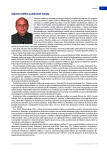An infection of the urogenital tract in female patients with diabetes
Authors:
Karol Dókuš 1; Silvia Dókušová 2
Authors‘ workplace:
Gynekologicko-pôrodnícka klinika Jesseniovej LF UK a UNM, Martin
1; Národný endokrinologický a diabetologický ústav, n. o., Ľubochňa
2
Published in:
Forum Diab 2016; 5(3): 151-154
Category:
Topic
Overview
Diabetes mellitus, in particular when insufficiently controlled, presents a risk factor for the development of infectious diseases, including those of the urogenital system of women with diabetes. The most frequently occurring infections of the urogenital organs in patients with diabetes mellitus include vulvovaginal candidiasis, bacterial vaginosis, trichomoniasis and aerobic vaginitis. The article presents an overview of the most common etiological agents and the preferred practices of treatment of these nosological units, with an emphasis on measures suitable for women with diabetic mellitus.
Key words:
aerobic vaginitis – bacterial vaginosis – diabetes mellitus – urogenital tract – vulvovaginal candidosis – trichomoniasis
Sources
1. Benfield T, Jensen JS, Nordestgaard BG. Influence of diabetes and hyper- glycaemia on infectious disease hospitalisation and outcome. Diabetologia 2007; 50(3): 549–554.
2. Njomnang Soh P, Vidal F, Huyghe E et al. Urinary and genital infections in patients with diabetes: How to diagnose and how to treat. Diabetes Metab 2016; 42(1): 16–24. Dostupné z DOI: <http://dx.doi.org/10.1016/j.diabet.2015.07.002>.
3. Hirji I, Andersson SW, Guo Z et al. Incidence of genital infection among patients with type 2 diabetes in the UK General Practice Research Database. J Diabetes Complications 2012; 26(6): 501–505. Dostupné z DOI: <http://dx.doi.org/10.1016/j.jdiacomp.2012.06.012>.
4. Achkar JM, Fries BC. Candida infections of the genitourinary tract. Clin Microbiol Rev 2010; 23(2): 253–273. Dostupné z DOI: <http://dx.doi.org/10.1128/CMR.00076–09>.
5. Buchta V, Matula V, Kestřánek J et al. Is diabetes mellitus a risk factor in genital yeast infections? Ceska Gynekol 2013; 78(6): 537–544.
6. Mylonas I, Bergauer F. Diagnosis of vaginal discharge by wet mount microscopy: a simple and underrated method. Obstet Gynecol Surv 2011; 66(6): 359–368. Dostupné z DOI: <http://dx.doi.org/10.1097/OGX.0b013e31822bdf31>.
7. Workowski KA, Berman S. Sexually transmitted diseases treatment guidelines, 2010. MMWR Recomm Rep 2010; 59(RR-12): 1–110. Erratum in MMWR Recomm Rep 2011; 60(1):18. Dosage error in article text.
8. Sobel JD. Factors involved in patient choice of oral or vaginal treatment for vulvovaginal candidiasis. Patient Prefer Adherence 2013; 8: 31–34. Dostupné z DOI: <http://dx.doi.org/10.2147/PPA.S38984>.
9. Sobel JD. Vulvovaginal candidosis. Lancet 2007; 369(9577): 1961–1971.
10. Iavazzo C, Gkegkes ID, Zarkada IM et al. Boric acid for recurrent vulvovaginal candidiasis: the clinical evidence. J Womens Health (Larchmt) 2011; 20(8): 1245–1255. Dostupné z DOI: <http://dx.doi.org/10.1089/jwh.2010.2708>.
11. Falagas ME, Betsi GI, Athanasiou S. Probiotics for prevention of recurrent vulvovaginal candidiasis: a review. J Antimicrob Chemother 2006; 58(2): 266–272.
12. Donders GG, Zodzika J, Rezeberga D. Treatment of bacterial vaginosis: what we have and what we miss. Expert Opin Pharmacother 2014; 15(5): 645–657. Dostupné z DOI: <http://dx.doi.org/10.1517/14656566.2014.881800>.
13. Schwebke JR, Muzny CA, Josey WE. Role of Gardnerella vaginalis in the pathogenesis of bacterial vaginosis: a conceptual model. J Infect Dis 2014; 210(3): 338–343. Dostupné z DOI: <http://dx.doi.org/10.1093/infdis/jiu089>.
14. Sharma H, Tal R, Clark NA, Segars JH. Microbiota and pelvic inflammatory disease. Semin Reprod Med 2014;32(1):43–49. Dostupné z DOI: <http://dx.doi.org/10.1055/s-0033–1361822>.
15. Mastromarino P, Vitali B, Mosca L. Bacterial vaginosis: a review on clinical trials with probiotics. New Microbiol 2013; 36(3): 229–238.
16. Coleman JS, Gaydos CA, Witter F. Trichomonas vaginalis vaginitis in obstetrics and gynecology practice: new concepts and controversies. Obstet Gynecol Surv 2013; 68(1): 43–50. Dostupné z DOI: <http://dx.doi.org/10.1097/OGX.0b013e318279fb7d>.
17. Forna F, Gulmezoglu AM. Interventions for treating trichomoniasis in women. Cochrane Database Syst Revs 2003; (2): CD000218.
18. Tansarli GS, Kostaras EK, Athanasiou S et al. Prevalence and treatment of aerobic vaginitis among non-pregnant women: evaluation of the evidence for an underestimated clinical entity. Eur J Clin Microbiol Infect Dis 2013; 32(8): 977–984. Dostupné z DOI: <http://dx.doi.org/10.1007/s10096–013–1846–4>.
19. Tempera G, Furneri PM. Management of aerobic vaginitis. Gynecol Obstet Invest 2010; 70(4): 244–249. Dostupné z DOI: <http://dx.doi.org/10.1159/000314013>.
Labels
Diabetology Endocrinology Internal medicineArticle was published in
Forum Diabetologicum

2016 Issue 3
Most read in this issue
- Diabetes mellitus and secondary immunodeficiency
- Chronic obstructive pulmonary disease, metabolic syndrome and diabetes mellitus
- An infection of the urogenital tract in female patients with diabetes
- Assessment of the development of head and neck infections – comparison of cohorts of patients with and without diabetes mellitus
